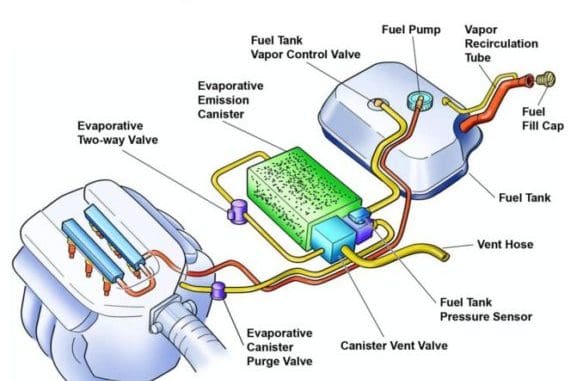```html
Is Your Car's EVAP System Trying to Tell You Something? Decoding the Mystery of Evaporative Emissions
Have you ever noticed a check engine light and wondered if it's serious? Chances are, your car's Evaporative Emission Control (EVAP) System might be the culprit. Don't panic! Understanding this system is easier than you think, and it could save you money and help the environment.
Why Understanding the EVAP System Matters
The Evaporative Emission Control (EVAP) System Explained simply, is designed to prevent harmful gasoline vapors from escaping into the atmosphere. This isn't just about regulations; it's about our air quality and reducing smog. Failing to address issues with your EVAP system can lead to:
- Failed emissions tests: Meaning you can't legally drive your car.
- Reduced fuel economy: Wasting your hard-earned money at the pump.
- Environmental damage: Contributing to air pollution.
- Potential fines: Depending on your location, driving with a malfunctioning EVAP system can result in penalties.
Key Components and Functions of the Evaporative Emission Control (EVAP) System
Let's break down the key components that make up the Evaporative Emission Control (EVAP) System:
Fuel Tank
The fuel tank stores gasoline. The EVAP system manages vapors that naturally form within this tank.
Charcoal Canister
This vital component acts like a sponge, absorbing and storing gasoline vapors until the engine is ready to use them. Think of it as a temporary holding cell for harmful emissions.
Purge Valve
When the engine is running, the purge valve opens, allowing the stored vapors from the charcoal canister to be drawn into the engine and burned. This process prevents the vapors from escaping into the atmosphere.
Vent Valve
The vent valve controls airflow into and out of the charcoal canister. This ensures proper pressure within the EVAP system and allows the vapors to be vented safely during refueling.
Fuel Cap
Believe it or not, a loose or faulty fuel cap is a very common cause of EVAP system problems! It maintains the sealed pressure required for the system to function correctly.
Common EVAP System Problems and Symptoms
Several telltale signs indicate potential issues with your Evaporative Emission Control (EVAP) System:
- Check Engine Light: This is the most common indicator.
- Gasoline Odor: A noticeable smell of gasoline, especially near the fuel tank, suggests a leak.
- Difficulty Starting: In some cases, a malfunctioning EVAP system can affect engine performance.
- Poor Fuel Economy: If you notice a sudden drop in gas mileage, the EVAP system could be to blame.
Diagnosing EVAP System Problems
While some issues, like a loose gas cap, are easy to fix, others require professional diagnosis. Mechanics use specialized tools, such as a smoke machine, to identify leaks in the system.
DIY vs. Professional Repair of the EVAP System
Some repairs, like replacing the gas cap or a damaged vacuum hose, can be tackled by confident DIYers. However, diagnosing complex problems and replacing components like the charcoal canister or purge valve often requires specialized knowledge and equipment. When in doubt, it's best to consult a qualified mechanic.
Expert Insights on the Future of EVAP Systems
With the rise of electric vehicles, some might think EVAP systems are becoming obsolete. However, gasoline-powered vehicles will remain prevalent for years to come, making the efficient operation of EVAP systems crucial for minimizing emissions. Furthermore, developments in biofuels and alternative fuels may introduce new challenges and require further advancements in EVAP technology.
Evaporative Emission Control (EVAP) System Explained: Frequently Asked Questions
What does it mean when my car has an EVAP leak?
An EVAP leak indicates that gasoline vapors are escaping from the Evaporative Emission Control (EVAP) System. This can be caused by a loose gas cap, damaged hoses, or a malfunctioning component like the charcoal canister or purge valve. A leak can trigger the check engine light and lead to reduced fuel economy.
How much does it cost to repair an EVAP system?
The cost of repairing an Evaporative Emission Control (EVAP) System varies depending on the cause of the problem. Replacing a gas cap might cost a few dollars, while replacing the charcoal canister or purge valve can range from $100 to $500 or more, including labor.
Can I drive my car with an EVAP system problem?
While youcantechnically drive your car with an EVAP system problem, it's generally not recommended. Besides the environmental impact, it can lead to poor fuel economy and potentially cause other issues. Moreover, you might fail an emissions test. Get it checked by a professional as soon as possible.
Conclusion: Keep Your EVAP System Healthy for a Healthier Planet (and Wallet!)
Understanding your car's Evaporative Emission Control (EVAP) System Explained is crucial for maintaining its performance, saving money on fuel, and protecting the environment. Don't ignore a check engine light or the smell of gasoline. If you suspect a problem, consult a qualified mechanic for diagnosis and repair. Schedule your EVAP system checkup today and drive with confidence!
Don't wait! Protect your car, your wallet, and the environment. Find a trusted mechanic near you for an EVAP system inspection.
```
